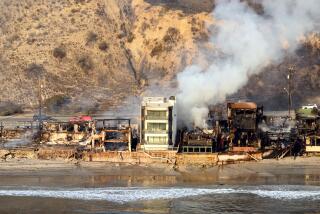9/11 Tower’s Fall Tied to Intensity of Fire
- Share via
WASHINGTON — Federal investigators believe the second World Trade Center tower fell much more quickly than the first because it had a more concentrated, intense fire inside, officials said Tuesday.
The detailed hypothesis was discussed at a meeting of investigators with the National Institute of Standards and Technology, part of the Commerce Department.
The institute’s investigators are preparing a report detailing how and why the towers collapsed after being struck by fuel-filled jetliners on Sept. 11, 2001. The report is to be released by year’s end
Lead investigator Dr. Shyam Sunder said the second tower collapsed more quickly than the first because the fire was more concentrated, weakening sections of interior and exterior support columns more quickly.
Tower 1 was struck first and stood for 103 minutes, almost twice as long as Tower 2, which remained standing for 56 minutes.
“In Tower 2, you had a large concentration of combustible debris in the northeast corner, and the fire there was a more persistent fire,” Sunder said.
The flames stayed strong in part because the impact of the plane stripped away much of the fireproofing along the floors, investigators said.
The investigators now suspect the stripping effect of the collision was far more decisive in the course of the fire than whether individual floors had more or less fireproofing material.
Investigators also say the towers would have probably remained standing were it not for the raging fires inside, which weakened the steel supports.
As the fire continued, the heat and extra stress on the interior support columns caused them to compress downward.
When the building’s steel skin couldn’t handle the extra weight, it began to buckle.
More to Read
Sign up for Essential California
The most important California stories and recommendations in your inbox every morning.
You may occasionally receive promotional content from the Los Angeles Times.












